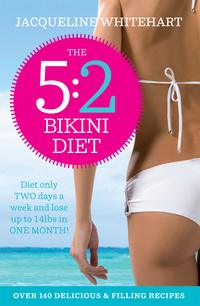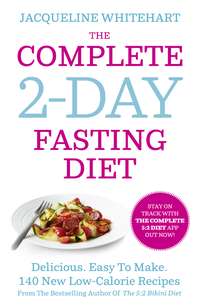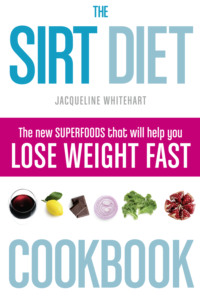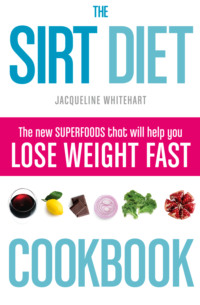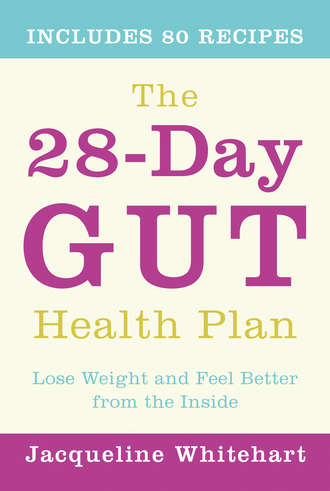
Полная версия
The 28-Day Gut Health Plan: Lose weight and feel better from the inside
Unfortunately, the popular probiotic drinks and enhanced foods don’t really cut the mustard when it comes to supplementing. To get any real benefit, you need a probiotic tablet or powder. The number of different bacterial strains, together with the concentration of bacteria, is most important for success.
The most proven and the one now being prescribed by specialists for IBS and similar illnesses is a brand of probiotic called VSL3 (www.vsl3.co.uk). This brand contains the most strains of good bacteria and has 450 billion bacteria per sachet. But it is expensive and needs to be kept refrigerated.
THE BLOATING PROBLEM
Probiotics plus more fibre can lead to extra bloating in the first week of the programme. When you start taking probiotics you could get more bloated not less. But if you care about improving your gut health, it’s a really important step. And in a strange way, it shows that the probiotics have started to do their job. They’ve started the battle and are breaking down foods that your body normally doesn’t digest, producing more gas. Give the probiotics a week during the Rest and Restore phase and you’ll see the bloating reduce. At the end of the week, your waist size and bloating will have reduced and be back to normal. You might even have lost weight and an inch or two round your tummy.
The more traumatized your gut the worse this will be. Give it a week. It will get better. And it means that a change for the better has begun. Don’t start the Introducing phases until it is resolved.
FIBRE VS INTOLERANCE
One of the key tenets of improving your gut health and soothing your bowel symptoms is keeping levels of both soluble and insoluble fibre high. But look at this list of fibre-rich foods:
Vegetables: broccoli (raw), cabbage, carrots (raw), peas and spinach
Grains: whole grain-breads, whole-grain cereals, oatmeal and bran
Beans/pulses: kidney beans, lima beans, black beans and lentils
And if we compare it with our list of top five food intolerances (see here), there’s a huge overlap! Broccoli and cabbage are gassy vegetables, bread and cereals all contain wheat, and don’t even get me started on how gassy beans can make you!
On the one hand, we need to restrict these possibly gut-intolerant foods. On the other, fibrous foods are needed to ensure smooth running of your insides. It’s a real conundrum and one that we can only fully address when we reach the end of the 28-day plan.
During the programme, you should up your consumption of safe fibre-rich foods. Most fruits, especially bananas and berries, are safe and rich in fibre. Oats are particularly good as they are very easy for the body to digest and are an excellent source of fibre.
If you look at the recipes, I use the odd-sounding psyllium husks in various recipes including my Seeded Gluten-free Bread (see here). Psyllium is a powder that forms a fibrous gel on contact with water. It should be used sparingly but is perhaps one of the purest sources of fibre. It can be sprinkled onto breakfast cereal and added to recipes to improve fibre content.
Finally, buckwheat, which contrary to its name contains no wheat or gluten at all, is a fabulous source of fibre. I particularly like using buckwheat pasta as that opens up the way to lots of delicious pasta sauces and bakes.
If you suffer from either constipation or diarrhoea, then increasing the fibre in your diet (from non-problematic sources) can make stools softer (good for constipation) or bulkier and more regular (good for diarrhoea).
Be aware, though, that just like the addition of probiotics to your diet, increasing your fibre intake can initially lead to bloating and constipation. So if you are adding all of these at once at the start of the 28-day programme, then you may find that some symptoms, particularly bloating, increase during this time. If it becomes too uncomfortable, cut out the additional fibre and concentrate on the probiotics in the first instance. Fibre can be added gradually later when you have a better understanding of your food intolerances.
UNDERSTANDING YOUR OWN SENSITIVITIES
The 28-Day Gut-Health Plan is all about understanding your own sensitivities. We all react differently to different foods, and as so many factors influence our gut health it’s often hard to pinpoint what’s wrong and why.
Is it the slice of toast that gave you stomach cramps? Or nervousness about an exam? Perhaps it’s your period? Or even the menopause? Did you sleep well last night?
By following this plan we are trying to cut out as many uncertainties as we can. We do this by eliminating the five most common food intolerances for a week. Then introduce the possible trigger foods one at a time. Key to success is accurate recording of symptoms using the Gut-Health Diary (see here).
HOW MUCH WEIGHT CAN I LOSE?
The amazing bonus of the 28-Day Gut-Health Plan is the weight loss that goes hand in hand with improving your gut-health. This happens simply because you are cutting back on processed foods and sugars, eating foods that your body can digest and eating three filling and balanced meals a day.
When you first give up all trigger foods during the Rest and Restore week, the weight loss can be quite dramatic. As much as one pound a day in the first week. The rate of weight loss is obviously dependent on how much weight you have to lose, but you should expect upwards of three pounds in the first week. After this, the weight loss will settle down but you should continue to lose weight at a rate of one to three pounds a week, depending on your personal intolerances. This diet is not a ‘fad’ diet; it’s a healthy way of eating and the weight loss is real and permanent.
TOP 5 WAYS TO MINIMIZE GUT STRESS
1. Don’t eat big fatty meals
Make your meals smaller by reducing your plate size. Realize that a ‘blow-out’ meal like a takeaway, fish and chips or lots of red meat will antagonize the strongest gut. This is made worse if the meal is eaten late in the evening, as you ‘sleep on your food’. Steer clear if you can. But if you can’t, take probiotics for at least a week afterwards and consider trigger food elimination to reset the gut.
2. Keep alcohol and caffeine levels low
Sadly for those of us that love both coffee and wine, alcohol and caffeine can have a negative effect on the gut. Caffeine is a stimulant and makes the gut overactive and increases bowel movements. Alcohol irritates the gastrointestinal tract, so can make your symptoms worse. Additionally, both alcohol and caffeine make you more dehydrated. The good news is that it is rare to be intolerant to alcohol or caffeine, so neither needs to be eliminated entirely. Just be aware of their effects and try and reduce consumption during the programme and when your gut health is poor.
3. Drink more water
Increasing the amount of water you drink is perhaps the easiest way to improve your overall gut health. It simply helps keep everything within the gut moving smoothly. Always keep a water bottle to hand and make sure you drink whenever you are thirsty. Additionally, drink a glass of water first thing in the morning (to wake up your digestion) and make sure you drink at least one glass of water before every meal and more during the summer months.
Remember, caffeinated drinks are diuretic (make you more dehydrated) and the bubbles in carbonated drinks can pass through the body undigested and cause uncomfortable wind.
Short answer: Water is best!
4. Keep away from artificial sweeteners
Artificial sweeteners such as sorbitol and sucralose can cause diarrhoea and flatulence even if you have a healthy gut. All sweeteners that end with an -ol should be avoided and watch out for the use of different names on packaging that are meant to confuse you into thinking these sweeteners are natural. All sweeteners are considered toxins by the body and your gut tries to expel them quickly.
5. Avoid ready meals and shop-bought baked goods
Ready meals and shop-bought baked goods can contain hidden triggers, and even a small amount of a trigger food could set you back. Use the tips and recipes in the book to make simple real food quickly. Low-fat or reduced-calorie foods are particularly bad as the good bits have been sucked out along with the calories and replaced with empty and unnatural fillers that can irritate the gut lining.
INITIAL GUT ASSESSMENT QUIZ
This initial assessment is vital in getting a baseline reading of the state of your gut health. It will help you compare objectively to others. Importantly, it will help you to answer the question:
‘Is it really that bad?’
YOUR OVERALL HEALTH
1.Do you have low energy or feel overly fatigued?

2.Do you consider yourself to be overweight?

3.Do you suspect you have food intolerances or allergies?

INFLAMMATION
4.Do you have skin complaints? For example, itchy skin, rashes, eczema, rosacea, acne, hives, psoriasis.

5.Do you have hay fever, dust or pet allergies?

6.Do you experience joint pain or unexplained muscle pain?

7.Do you suffer from frequent sinus pain or other sinus-related issues?

8.Do you get problems such as brain fog, chronic headaches, anxiety?

YOUR DIGESTION
On average, and when eating without restrictions, how many days a week do you suffer from:
9. Stomach cramps:

10. Diarrhoea:

11. Constipation:

12. Bloating:

13. Acid reflux:

14. Excessive wind:

WORKING OUT YOUR SCORE
Add up the scores for every question (1–14) and use the chart below to check the current state of your gut health.
Gut-Health Total……………………………………………
My Gut-Health Score………………………………………
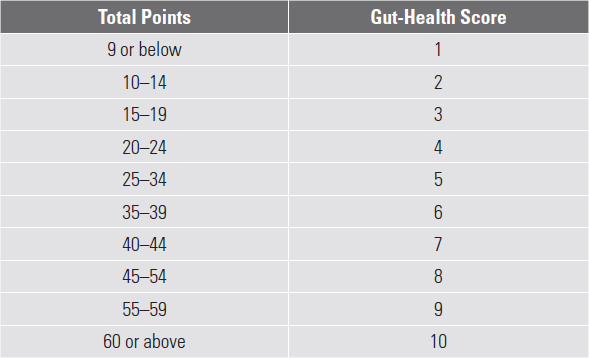
WHAT DOES YOUR GUT-HEALTH SCORE MEAN?
9–10 Severe
Disrupts your everyday life.
You may already be under the care of your doctor, and if not you should consider it.
The Gut-Health Plan may help you but you should also take medical advice. Be prepared for the programme to take longer than normal, and to find many food sensitivities.
7–8 Moderate to Severe
Although your gut health doesn’t bother you every day, you suffer more often than not and are always thinking about it.
The Gut-Health Plan should help you to get to grips with your gut-health. You are likely to find one or more food sensitivity.
3–6 Mild to Moderate
Your gut health doesn’t affect you every day. But it is slowly but surely getting worse. You might find that it gets worse during periods of stress and uncertainty and at inconvenient times, such as when you are on holiday.
The good news is that this programme can help reverse the flow and help you understand and improve your gut health.
1–2 Mild
You may suffer from occasional symptoms. You are unlikely to have any intolerances. If you feel that your gut health is getting worse, then this programme will get you back to optimum gut health.
THE 5 BIG TRIGGERS
During the 28-Day Gut-Health Plan we are concentrating on the five most common food triggers for gut health:
1.Lactose (Milk)
2.Red Meat
3.Nightshade family (tomatoes, (bell) peppers, chilli peppers, aubergine)
4.Gas-producing (gassy) Vegetables (onions, garlic, broccoli, beans)
5.Wheat
We are concentrating here on food intolerances as opposed to allergies.
An intolerance:
Develops over time
Gets worse as you get older
Doesn’t always affect you in the same way
Can allow you to still eat the food in smaller quantities
With food allergies, you are either born with them or develop them as a young child. The reaction to foods is intense with only a very small quantity. Your food allergy may have involved medical treatment of some kind, although there is no cure. If you have an allergy, it is very black and white. You know about it and are hopefully receiving medical support. For our purposes, being coeliac is definitely an allergy. If you have an allergy, you can still find support for other possible food intolerances in this book and hopefully find recipes that support your allergy and your lifestyle.
Remember that any food intolerances develop from an underlying gut-health problem. You can inherit gut-health problems or they can be caused by the foods you eat and the lifestyle you follow. This is why gut-health symptoms tend to worsen as you get older.
We start to mend the gut by first introducing probiotics. These will improve the bacterial balance. Foods will be digested better and are less likely to come into contact with the gut wall. Although probiotics will improve your entire gut, it is a slow process and doesn’t deal directly with any food intolerances you might have developed.
For this reason, in addition to the probiotics, we start the 28-Day Plan with a 7-Day Rest and Restore phase that removes the five common food triggers from your diet. By removing the intolerance (the food that your body considers most toxic), we can reduce the inflammation in the lining of the gut. It is only then that the gut can start to heal.
When the gut has started to heal and symptoms have reduced, we can then reintroduce trigger foods gradually and see what effects they have on YOUR body. The aim of the programme is not only to improve the health of your gut, but also to understand your own specific food intolerances so that you can learn to balance the foods you eat with the effect they have on your body.
We introduce food groups in a particular order, with the trickiest and most difficult triggers to diagnose coming last – gassy vegetables and wheat.
LACTOSE (MILK)
Lactose or milk sugar is a sugar found only in milk or milk products.
Milk vs Dairy
A common misconception, however, is that anything made from milk contains lactose. Which is why some people may be confused and eliminate all dairy from their diet.
Dairy does define all food made from milk. However, in ‘hard’ or solid dairy products such as butter or cheese all the lactose has been removed. If you think back to domestic science, or perhaps even the nursery rhyme, milk is split into curds and whey. Curds is the solid protein and fat and contains no lactose.
An even simpler definition is:
‘If you have to cut it with a knife, it’s safe.’
Milk (lactose) foods to avoid
Milk, all types including skimmed and semi-skimmed
Cream
Custard
Fromage frais
Ghee
Ice cream
Margarine
Sour cream
Yogurt
Milk or white chocolate
Soft cheese such as cottage cheese, cream cheese, halloumi
Additionally, check the ingredients list on: cereals, baked goods, crisps, cooked meats and soups. Look out for any of these in the nutritional information, as they all signify lactose: casein, caseinates, sodium caseinates, hydrolysed casein, milk powder, milk solids.
Safe dairy foods
Butter
Hard cheese such as Cheddar, feta and Parmesan
Note that eggs are not a dairy food, contain no lactose and can be eaten safely.
Using lactose-free milk to simplify the removal of milk lactose from your diet
Lactose-free milk is now commonly available in every supermarket and is a really simple way to cut out lactose from your diet and see if it makes a difference to your gut health. You can also buy lactose-free yogurts, soft cheese and cream.
RED MEAT
Red meat can be problematic for your gut health for two reasons:
1.Red meat is simply one of the hardest things for your gut to break down and digest. It is often the case that occasional small quantities of red meat are OK for all but the most sensitive digestions. But increase the quantities, eat it late at night or together with a large, fatty meal and the likelihood of a problem increases hugely.
2.The other problem with red meat can be bacterial. This could mean that you have a problem with one meat in particular, be that beef, pork or lamb. This sometimes happens if you’ve had a bad bout of meat-related food poisoning in the past. The gut becomes colonized by the bad bacteria and you stay sensitive for years afterwards. Probiotics really help here as they can reduce or eliminate the problematic bacteria.
On the plus side, it is unlikely that you will have to eliminate red meat entirely from your diet. Just remember moderation is always the key to avoiding problems with red meat. If you do have a problem, cut out all red meat for at least forty-eight hours until all symptoms have passed.
Red meat to avoid
All forms of beef, lamb, pork and game
Minced beef
Burgers
Sausages
Ham
Duck
Game
Bacon
Salami
Chorizo
White meat (you can eat as much as you like)
Chicken
Turkey
All parts of the bird can be eaten, including the dark meat, such as turkey thigh.
NIGHTSHADE
Fruits from the nightshade family – tomatoes, bell peppers, chillies and aubergines (eggplants) – contain glycoalkaloids and/or capsaicin, which are surprisingly common triggers for a sensitive gut. It is estimated that as many as one in three of us could be sensitive to nightshades, although for many people it is a minor rather than major intolerance.
The highest concentration of glycoalkaloids is found in tomatoes. Tomatoes, either fresh, tinned or in pastes or passatas, are harder to avoid than you might imagine. Many dishes, from stews to curries, have tomatoes as their base. The problem with glycoalkaloids is that they can destroy cell membranes and can ‘burst open’ cells. This property is part of their natural defence against small mammals and birds that like to eat the sweet fruits of these plants. To the smaller stomachs of these animals, the glycoalkaloids have a toxic effect. As a much bigger animal, humans should be immune to their effects, but unfortunately, weakened gut linings have made people more susceptible to their effects. It has been suggested that by damaging the gut lining they may be one of the causes of leaky gut.
The other molecule in these red (and green) fruits is the tricky capsaicin. Capsaicin has a very different but equally nasty effect on the gut. Capsaicin is an irritant, and in the same way that you get pain and watery eyes if you just touch your eyes after chopping a chilli, capsaicin can irritate and inflame the gut lining, causing stomach cramps and pain. All chillies, fresh, dried or in powder form, contain the dreaded capsaicin. In fact, all red spices – e.g. paprika, chilli powder, cayenne pepper – contain concentrated capsaicin and should be avoided.
Fresh chilli peppers contain both glycoalkaloids and capsaicin, so are ‘the perfect storm’ when it comes to nightshade sensitivity.
Foods to avoid
Fresh tomatoes
Tinned tomatoes
Tomato purée
Tomato ketchup
Peppers (bell) – red, green, yellow and orange
Aubergine (eggplant)
Chilli peppers
Pimento peppers
Chilli paste
Chilli sauce
Jalapeños
Paprika
Mild or hot chilli powder
Curry powder
Madras powder
Cayenne pepper
Basically the food rule is:
‘Steer clear of red foods.’
GAS-PRODUCING (GASSY) VEGETABLES
Most of the carbohydrate foods we eat release bubbles of gas as they are digested. In some people, it is not the gas in itself that causes the problem; it is how our bodies deal with the bubbles. If you are sensitive to gas-producing foods then it is likely that you suffer from painful stomach cramps as the gas gets trapped and your body tries to push it through the digestive tract. Unfortunately this gets worse at night as we are lying down ‘at rest’ and the natural movement of the body and gravity are not there to help push the gas away.
Gas-producing vegetables are perhaps the most common problem for people with a sensitive gut. Some troublesome veggies such as beans and cauliflower are relatively easy to avoid. But perhaps the most difficult foods are onions and garlic. They are incredibly tricky to steer clear of because they make their way into all sorts of unexpected foodstuffs, being a key flavouring for many meals. And secondly, they are the absolute worst at causing the production of gas. Even a tiny amount can trigger a reaction and cause a sleepless night.
Total abstinence from these foods is advised. I know this is difficult, but it might just be the root of so many gut issues that it is absolutely worth the effort. Use the recipes in this book to help. There is a huge variety of meals and flavours to stop your food being bland. Then learn the few key food swaps – lactose-free milk, celery, asafoetida and garlic oil (see here) – that can really make things easier. And think positive … You may never have to chop an onion again!
Foods to avoid
Onions and garlic
Red onion
White onion
Spring (green) onion (white part)
Onion powder
Onion flavouring



